Sightseeing in game parks featuring the rolling savannah landscapes of Kenya and Tanzania apart, the prime agenda of the 12-day excursion was to retrace the entrepreneurial journey of my late India-born father, reports dilip thakore
 As people get on in years and approach the biblically ordained lifespan of three score and ten, it’s natural to become incrementally nostalgic about the water-colour days of childhood and early youth in simpler, halcyon, and arguably more joyful times when the law’s delay, the insolence of office and the proud man’s contumely were less ubiquitous.
As people get on in years and approach the biblically ordained lifespan of three score and ten, it’s natural to become incrementally nostalgic about the water-colour days of childhood and early youth in simpler, halcyon, and arguably more joyful times when the law’s delay, the insolence of office and the proud man’s contumely were less ubiquitous.
This was the impulse that prompted your correspondent to gather his brother and sister and others near and dear, to chart a brief excursion to two territories of former British East Africa — latter-day Kenya and Tanzania — where we had spent our early years and vacations from boarding schools in India. Sight seeing in game parks feat-uring the rolling savannah landscapes surrounded by blue hills in the distance, and the region’s fabled animal species carefully conserved in free and natural environments apart, the prime agenda of the 12-day excursion was to retrace the footsteps and entrepreneurial journey of my late India-born father Vinoo Thakore (1906-95), who arrived steerage in Mombasa in 1920 with a working capital of 14 annas (Rs.0.85) to seek adventure and fortune in the Dark Continent.
Half a century later after many adventures, including an unusual for those times ‘love marriage’ with my Zanzibar-born mother Malati Sule, 20 years younger, he returned to India having rescued most of his considerable fortune from the frying pan of African socialism, only to run into the fire of Nehruvian socialism and 20 percent per annum inflation of the 1970s, which considerably diminished his capital.
Nevertheless he had left his stamp and imprint on Africa, having estab-lished several businesses including the first milk pasteurisation plant in North Tanganyika (as it then was); purchasing a 5,000-acre sisal (a cactus-like plant which produces heavy-duty ropes manufacturing fibre) estate; and later restoring to health a langui-shing timber sawmill business with a 3,000-acre forest concession in Molo, Kenya. Simultaneously, our parents discharged their familial obligation to the full by educating us children in boarding schools in India and later in universities in Britain, enabling us to make our way in the world despite their considerably diminished fortune in their latter years.
Forty years later when we could afford it, my London-based sister Shyama, Vadodara-based brother Anil and your correspondent in Bangalore planned a sentimental journey from November 4-16, 2011 to trace the extraordinary life and times of one of the many unsung Indian entrepreneurs who modernised the nations of British East Africa. In the process, we rekindled our association with forgotten landscapes of great natural charm and carefully preserved game parks, inhabited by cheerful, friendly people struggling — like our own citizens back home — to rise out of poverty despite the self-serving machinations of greedy politi-cians and an unjust global order.
November 4, Mumbai. This carefully mapped sentimental trip to E.Africa required us three siblings to travel together to once-familiar places and reminisce and share memories. But the entire excursion was nearly sabotaged ab initio because the visa of my London-based sister Shyama to India had expired two days earlier. According to the immigration officer — one Ritesh N.C. — at Mumbai’s ramshackle inter-national airport, this constituted a grave offence which required her to return to her point of embarkation (Bangalore) to renew her visa.
No amount of explanations, tears or threats could prompt him to change his mind. Ritesh’s colleague wanted to “settle” the matter, but having learned that I am a journalist, Ritesh became an exemplary upholder of the law. Unfortunately, this type of envious, unbending babu is ubiquitous in India. In great anxiety, we had to board the flight without her. After 10 hours of forms-filling and waiting the next day at the foreigners’ registration office in Mumbai and paying Rs.5,000 penalty for this heinous crime, she joined us the following day in Nairobi. Incredible India indeed!
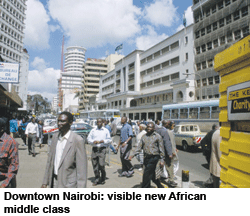 November 5, Nairobi. After enduring a six-hour no-frills, poor service flight by Kenya Airways, we arrived at the Jomo Kenyatta International Airport where visas are smoothly issued on arrival. By Indian standards, Nairobi (pop.3 million) is a well-administered metropolis somewhat reminiscent of New Delhi. A prosperous new African middle class is visible in the steel and glass office towers of downtown Nairobi. The Asian community from the Indian subcontinent is no longer seen in front-line selling, with most of Kenya’s 59,000-strong Indian population having graduated into manufacturing and/or wholesale and distribution businesses. Vehicular traffic is heavy but disciplined. Amazingly, drivers slow down and even stop at pedestrian crossings, and rarely blow car-horns.
November 5, Nairobi. After enduring a six-hour no-frills, poor service flight by Kenya Airways, we arrived at the Jomo Kenyatta International Airport where visas are smoothly issued on arrival. By Indian standards, Nairobi (pop.3 million) is a well-administered metropolis somewhat reminiscent of New Delhi. A prosperous new African middle class is visible in the steel and glass office towers of downtown Nairobi. The Asian community from the Indian subcontinent is no longer seen in front-line selling, with most of Kenya’s 59,000-strong Indian population having graduated into manufacturing and/or wholesale and distribution businesses. Vehicular traffic is heavy but disciplined. Amazingly, drivers slow down and even stop at pedestrian crossings, and rarely blow car-horns.
In the afternoon, we undertook a city tour by a private SUV taxi (Kenya Shillings (KS) 3,000 or Rs.1,500). The highlight was a visit to a new Uhuru Park which runs through the city and is a popular picnic site, and a drive through the Parklands suburb where the Indian community lives in neat and scenic bungalows. With the Ngara area experiencing a massive makeover, I couldn’t locate The Duke of Gloucester School (since renamed) where I passed my A levels. And yes, Mumbai-type slums are visible in this cool and pleasant (summer temp. 22-15°C) city with Indian-style income disparities.
November 6, Arusha. After overnighting at the Hilton Hotel, Nairobi (service: poor by Indian 5-star standards) we departed for Arusha after breakfast by a 4-wheel drive land cruiser arranged by our tour organiser Fatma Chandani of Discover Kenya Safaris and Discover Tanzania Safaris. Our English-speaking driver-cum-guide Victor was a mine of information, keeping us engaged as we drove in leisurely comfort down a well-maintained tarmac road reaching the border town of Namanga around noon, where the land cruiser was handed over to our Tanzanian driver Ellie. After acquiring on-arrival visas (US$ 50/Rs.2,600 each), we zipped along an excellent new Chinese-built road to reach Arusha at around 4 p.m. This was a very special day for us as it was the birthday of our late mother Malati (1926-97). We were back in the town where we spent our childhood in the cosiness of a tight-knit community. Mother had acquired an excellent reputation for starting a high-quality preschool for Arusha’s small Indian community.
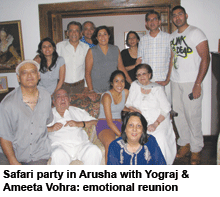 In the afternoon after we had checked into the newly-built Meru Hotel which we had erroneously assumed was the same as an eponymous hotel owned by my Dad — the first upscale multi-racial hostelry in Arusha — we met up with Yograj Vohra (88) whose father Krishna had been my father’s partner in a major real estate project in Arusha. We three remembered Krishna and Yograj disti-nctly and it was an emotional reunion with Yograj, his wife Ameeta, brother Anshi and sister Aruna Nanda. Currently, the Vohra family owns and manages several coffee estates and related businesses around Arusha.
In the afternoon after we had checked into the newly-built Meru Hotel which we had erroneously assumed was the same as an eponymous hotel owned by my Dad — the first upscale multi-racial hostelry in Arusha — we met up with Yograj Vohra (88) whose father Krishna had been my father’s partner in a major real estate project in Arusha. We three remembered Krishna and Yograj disti-nctly and it was an emotional reunion with Yograj, his wife Ameeta, brother Anshi and sister Aruna Nanda. Currently, the Vohra family owns and manages several coffee estates and related businesses around Arusha.
After swapping tales and memories over tea, Yograj informed us that the huge 100,000 sq.ft commercial-cum residential building constructed and managed by our progenitors had been expropriated without any compensation by the Tanzania government during its socialist heyday of the 1960s, and that several decades of effort to get compensation had proved futile. Current status: written off.
November 7, Dolly Sisal Estate. This was the most important day of our Africa excursion. Our objective was to revisit Dolly Sisal Estate where our nuclear family had spent its happiest days, and to locate the exact spot of our home on the sprawling estate. An internet search revealed that over 1,000 acres of the estate has been converted into a golf and polo club and a luxury housing complex of over 400 one-two acre plots. But when we entered the estate it was a shock to discover that the neat, even if monotonous, rows of sisal had completely vanished and the land was overrun by bush and scrub. After much driving around, we found the Spanish-style hacienda of the European manager of the leisure resort complex. But with the typical bad manners of whites in Africa who specially resent Indians, he was too busy to meet with us and direct us, although he sent word that we were free to search for our home site in the bush.
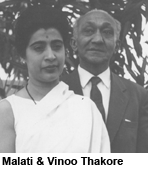 We drove around inside the scrub and bush of the estate for an hour without success. Almost half a century later nobody seemed to remember; the search party was dispirited and irritable. But since visiting the site of our home on Dolly Sisal was the raison d’etre of our sentimental safari, I was determined not to give up. I directed Ellie to drive to the river which I remembered had coursed behind our home which we had forded to build a natural swimming pool. When we got to the river, we abandoned the land cruiser and followed it southward on foot, hacking our way through the bush and scrub.
We drove around inside the scrub and bush of the estate for an hour without success. Almost half a century later nobody seemed to remember; the search party was dispirited and irritable. But since visiting the site of our home on Dolly Sisal was the raison d’etre of our sentimental safari, I was determined not to give up. I directed Ellie to drive to the river which I remembered had coursed behind our home which we had forded to build a natural swimming pool. When we got to the river, we abandoned the land cruiser and followed it southward on foot, hacking our way through the bush and scrub.
Perhaps two miles downstream we were impeded by a stone boundary wall. A hacienda was under construction, but the area seemed familiar. Disrespecting property rights I jumped the wall together with my daughter Bharati. Suddenly we were on familiar ground. Although the main cottage where my parents lived had been razed to the ground, an annexe which I had commissioned as a school boy — comprising two bedrooms and bathroom — was intact, though roofless and used by constr-uction labour as a kitchen. Likewise, a swimming pool I had designed but which emerged as a water tank was still around as were the servants quarters.
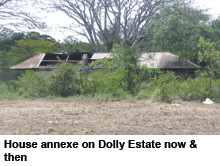 Standing on the foundations of the demolished cottage and spending precious moments by the riverside where we picnicked and sported so often, opened up the sluice gates of locked memory and emotions. The discovery of the site of our home on the estate — two miles from our nearest neighbour — was indeed the biggest high of Africa re-visited, particularly as it created a context for the many stories of my youth I had narrated to my wife and daughter. And we had arrived just in time: the hacienda being built by a mzungu (white man) was almost complete and all other buildings on the site were targeted for demolition. Had we come next year, we would never have
Standing on the foundations of the demolished cottage and spending precious moments by the riverside where we picnicked and sported so often, opened up the sluice gates of locked memory and emotions. The discovery of the site of our home on the estate — two miles from our nearest neighbour — was indeed the biggest high of Africa re-visited, particularly as it created a context for the many stories of my youth I had narrated to my wife and daughter. And we had arrived just in time: the hacienda being built by a mzungu (white man) was almost complete and all other buildings on the site were targeted for demolition. Had we come next year, we would never have  recognised the site of our most loved home.
recognised the site of our most loved home.
Mission accomplished and highly elated, we headed back into Arusha town. There were other heritage sites to visit. After lunch at the Indian-run Naaz Café hosted by Aruna Nanda, who runs a tourism company, we set about the rediscovery of Arusha (pop. 1.4 million).
Forty-plus years later the office of Fresh Supplies Ltd — an agri-business company promoted by my Dad and his partner Sadruddin (‘Jimmy’) Rahim which had established North Tanz-ania’s first milk pasteurisation plant — is now a lawyer’s office. The site of Arusha’s original Meru Hotel, promoted by my sire — and confiscated without compensation — is occupied by an ugly pink commercial building, and the office of his Tanganyika Land Agency is a curio shop.
Within walking distance is the spruced up and fully-tenanted 100,000 sq. ft Vanessa Building constructed and co-owned by my father and the Vohra family, expropriated without a penny in the private interest of a public official no doubt, and earning somebody or bodies huge rents. But that’s socialism the world over and water under the bridge. At the end of a bitter-sweet but fulfilling day, we retired to sleep well in the new Mt. Meru Hotel in the shadow of the eponymous mountain (14,000 ft), a mute witness.
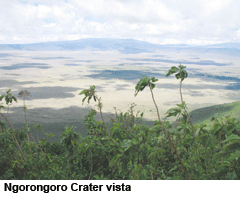 November 8-9, Ngorongoro Wildlife Sanctuary. The fabled game parks of Tanzania and Kenya beckoned and it was time to visit them. Our first destination was the Ngorongoro wildlife sanctuary. A four-hour drive from Arusha over smooth tarmac, past Lake Manyara — one of the largest fresh water bodies in the world (200 sq. km) — brought us to the gates of the sanctuary and the rim of a hilly range which surrounds the Ngorongoro crater. Below is a huge 260 sq. km flat plain formed by the collapse of an extinct volcano abundant with wild game including the Big Five — lion, elephant, wild buffalo, rhino and hippo.
November 8-9, Ngorongoro Wildlife Sanctuary. The fabled game parks of Tanzania and Kenya beckoned and it was time to visit them. Our first destination was the Ngorongoro wildlife sanctuary. A four-hour drive from Arusha over smooth tarmac, past Lake Manyara — one of the largest fresh water bodies in the world (200 sq. km) — brought us to the gates of the sanctuary and the rim of a hilly range which surrounds the Ngorongoro crater. Below is a huge 260 sq. km flat plain formed by the collapse of an extinct volcano abundant with wild game including the Big Five — lion, elephant, wild buffalo, rhino and hippo.
We were housed on the rim of the crater in the imaginatively constructed Sopa Safari Lodge, built on several levels with each room overlooking the slopes of the crater-plain on which zebra, giraffe, and deer graze comfortably. The whole of the next day was expended driving across the flat plain of the crater to view the magnificent animals in their natural habitats. Suffice it to say that we saw them all including the Big Five. The day was punctuated with a wonderful picnic lunch at a lush water body in which massive hippos frolicked in the distance. It’s also pertinent to note that unlike tourism spots back home, excellent toilet facilities have been constructed and maintained at the entrance of the sanctuary and in several locations within.
 We also squeezed into our packed day a visit to an allegedly typical Masai village which charged an entrance fee of US$ 60 (Rs.3,120) per car. It was inhabited by the large family of a chief with 16 wives who had borne him 70 children, the eldest of whom spoke excellent English. He was also sufficiently enamoured with my daughter Bharati to offer a bride price of 1,300 cows, a handsome offer which she for mysterious reasons declined.
We also squeezed into our packed day a visit to an allegedly typical Masai village which charged an entrance fee of US$ 60 (Rs.3,120) per car. It was inhabited by the large family of a chief with 16 wives who had borne him 70 children, the eldest of whom spoke excellent English. He was also sufficiently enamoured with my daughter Bharati to offer a bride price of 1,300 cows, a handsome offer which she for mysterious reasons declined.
November 10-11, Masai Mara Reserve. After an over-provided breakfast, the party was back on the road to Arusha. Our destination was Kilimanjaro Airport. Arriving in the afternoon, after lunch at the airport, we emplaned a 12-seater Air Kenya plane to fly to Nairobi (50 minutes) and from there caught a connecting Air Kenya flight (45 minutes) to the famous Masai Mara game reserve. Thanks to Discover Kenya Safaris, we were greeted by our friendly first-leg driver-cum-guide Victor at the airport. That is apart from a posse of zebra and herd of elephants just beyond the airport perimeter. We signed in at the magni-ficent 5-star Mara Serena Lodge (commissioned by Prince Amyn Aga Khan in 1979).
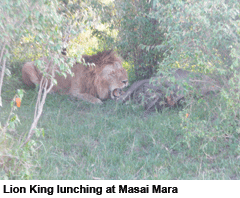 After an early night and deep sleep (temperatures drop sharply at night), the next day was spent cruising around the 1,800 sq.km game reserve. By now, spotting herds of zebra, gazelles, giraffe, wart hogs and wildebeest had become commonplace. But once again we saw the Big Five at work and play, the highlight being a regal lion feasting on a wildebeest he had felled by the river and dragged into a thicket.
After an early night and deep sleep (temperatures drop sharply at night), the next day was spent cruising around the 1,800 sq.km game reserve. By now, spotting herds of zebra, gazelles, giraffe, wart hogs and wildebeest had become commonplace. But once again we saw the Big Five at work and play, the highlight being a regal lion feasting on a wildebeest he had felled by the river and dragged into a thicket.
November 12, Nairobi. Having seen enough wildlife in Masai Mara, we skipped the early morning game drive and after breakfast at a sensible hour, our landcruiser hit the road cutting through the reserve and headed for our base point in Nairobi. For the first time in ten days we encountered a really badly potholed India-style road for over 67 km all the way to the town of Narok. That bone-jarring ride lasted over two hours and it was with considerable relief that we halted for lunch at Narok (pop.40,000). However after lunch it was smooth-going all the way to Nairobi which we reached at 3.30 p.m. In the afternoon, there was shopping in the parking lot of Parliament, which on weekends transforms into a giant Masai market with magnificent hand-crafted wares on sale. The stall owners are aggressive and persistent and more was bought than we required. Although the Nairobi Hilton is not much to write home about, it boasts an excellent Italian restaurant which provided a princely dinner at Bangalore prices.
November 13, Nakuru. Another important stop in our sentimental journey was the town of Nakuru. Here, our parents had lived for eight years after leaving Arusha to manage Mt. Blackett Saw Mills in Molo, located high in the neighbouring hills. Nakuru (pop. 300,000) was also where all of us — while studying abroad — had conv-ened for a memorable dinner in 1968 at the Stag’s Head Hotel to celebrate our parents’ 25th wedding anniversary.
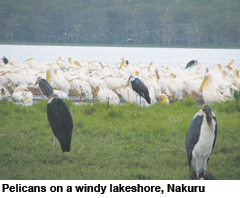 The drive to Nakuru mandates crossing the escarpment of the Great Rift Valley which offers awesome vistas en route. Three hours later, we were in Nakuru where we found the Stags’ Head Hotel now renamed The Merica, and also the ground floor flat in which my parents had lived for seven years, though we were not allowed in by a startled preacher’s wife who now lives there. After a quick lunch, we began a tour of Lake Nakuru Park to observe flocks of pelicans, pink flamingos and great white herons in abundance. Our luck was good as we also spotted hippos and crocodiles sunning themselves as also two black rhinos, apart from several beautifully plumed avian species. That night, following an over-generous buffet dinner — meals in all hotels were excellent — we were entertained by a native troubadour whose repertoire comprised several Bollywood hits including kuch kuch hota hai.
The drive to Nakuru mandates crossing the escarpment of the Great Rift Valley which offers awesome vistas en route. Three hours later, we were in Nakuru where we found the Stags’ Head Hotel now renamed The Merica, and also the ground floor flat in which my parents had lived for seven years, though we were not allowed in by a startled preacher’s wife who now lives there. After a quick lunch, we began a tour of Lake Nakuru Park to observe flocks of pelicans, pink flamingos and great white herons in abundance. Our luck was good as we also spotted hippos and crocodiles sunning themselves as also two black rhinos, apart from several beautifully plumed avian species. That night, following an over-generous buffet dinner — meals in all hotels were excellent — we were entertained by a native troubadour whose repertoire comprised several Bollywood hits including kuch kuch hota hai.
 November 14-15, Mombasa. Unknown to people of the subcontinent, the Kenya coast boasts splendid beaches spread of pure white sand and clear waters where we had vacationed en famille. Therefore it seemed apposite to conclude our ‘Kenzania’ sojourn with rest and recreation in Mombasa, the ancient African-Arab town with which Indian merchants were trading long before Vasco Da Gama discovered the sea route to India in 1498 for European powers, and opened up the Pandora’s Box of colonial rule in Africa and Asia. Weary after days of touring the game parks, we didn’t see much of the traffic-choked city of Mombasa (pop. 966,000) except its ancient Fort and the famous Lighthouse promenade.
November 14-15, Mombasa. Unknown to people of the subcontinent, the Kenya coast boasts splendid beaches spread of pure white sand and clear waters where we had vacationed en famille. Therefore it seemed apposite to conclude our ‘Kenzania’ sojourn with rest and recreation in Mombasa, the ancient African-Arab town with which Indian merchants were trading long before Vasco Da Gama discovered the sea route to India in 1498 for European powers, and opened up the Pandora’s Box of colonial rule in Africa and Asia. Weary after days of touring the game parks, we didn’t see much of the traffic-choked city of Mombasa (pop. 966,000) except its ancient Fort and the famous Lighthouse promenade.
We headed straight to the beautifully landscaped Mombasa Serena Resort, Bamburi beach — constructed in Arabic architectural style — with sprawling lawns shaded by coconut palms. Dotted with frangipani trees, the Arabian Sea washes up to its boundary walls.
The crowning point of the concl-uding two-day stopover at the Serena, Mombasa was a coral reef snorkeling expedition which revealed aquatic wildlife not quite on a par with that of Kenya’s game parks. The last day was topped off with the arrival from Nairobi of Yusuf Kehsavjee, my classmate at the Duke of Gloucester School where I had read for my A levels. It was the perfect end to a return-to-roots journey to the high-potential African continent with which India Inc is re-establishing pre-colonial historical ties.